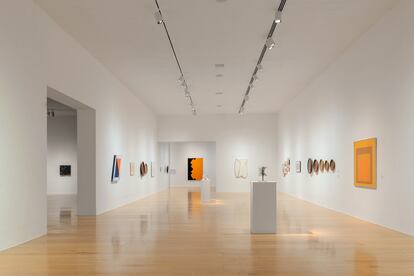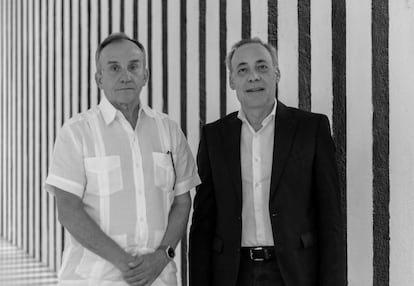The Venezuelan Juan Carlos Maldonado (Puerto Ordaz, 1963) threw himself fully in 2005 in the waters of collecting. Before, he has confessed, he had no works of art, but inspired by his aunt, the collector Milagros Maldonado, began a trip that has led him to gather one of the most important collections in Latin America. The businessman and patron also was attracted to the abstract geometry of modern Latin American teachers and later by the aesthetics of baskets and objects produced by the Ye’Kwana community, a Caribbean tribe settled between Brazil and Venezuela. Maldonado has made a fusion of both forms of creation that are part of a great exhibition that opens from this weekend the Museum of Contemporary Art of Monterrey, Marco, in which it is also a beautiful tension between modernity and the ancestral relationship with nature.
Maldonado speaks with passion of his collection and emphasizes what he defines as “the sophistication of a tribal group” such as the Ye’Kwana, indigenous people who attract him, he says, for his “very organized sustainability”, based on fishing, on hunting, but protecting the environment “to survive and not exhaust it.” “In the modern world, you realize how we have so many tools and work every day to exhaust everything that is around us and destroy the environment. And I believe that from the philosophical point of view there is a very important message: how these people who have so little have greater happiness and achieve at the end of the day survive with respect to nature, while modern man really destroys it,” explains the collector.
The sample, entitled Convergences / divergences. Two aesthetics, a sensitivity, It presents from the Ye’kwana community a beautiful collection of baskets and products for daily use carved with delicacy, which are perfectly coupled with the work of teachers of abstract art and their geometric and avant -garde shape abstract-geometric and indigenous art ”.
“I tried to understand which points of contact we could find among artists from communities, ideologies and aesthetics so different that they allowed an accessible dialogue for a western audience. We all know that modern and contemporary art often feeds the first cultures of Africa, from Oceania, from North America, of South America. I was forced to work, say, comparing you to you to you And trying to get points of convergence, but also respecting the divergence points that may exist, because there cannot be a real dialogue if there is no respect for differences, ”explains Jiménez.
A common point between the Ye’Kwana community and the artists of the collection, explain from Marco, is “the creation conditioned from generative models”, that is, while in modern and contemporary art artists use “technical and scientific methods” to generate visual effects, “the Ye’Kwana reproduce a tradition linked not only to the technical, but to their worldview”. “The interest of our institution is to show” the artistic contemporaneities in dialogue through this transgressive conversation between the artistic creations of one of the original cultures of the Amazon and artists of geometric, abstract, whose ideas were marked by rational thoughts from aesthetic positions from the mid -twentieth century, such as minimalism, kinetic movement or neocconcret Pimentel, director of Marco.
The exhibition, which will be open until October 26, is divided into three parts: Technical functionality and symbolic valuewhich shows indigenous functional objects opposed with modern creations that explain how some artists were inspired by popular arts to create their geometric shapes. The second part, entitled Generative modelsexplore the differences between indigenous creations and techniques of modern artists, who use scientific methods to create visual forms and effects, while Ye’Kwana are loyal to a tradition linked to their worldview. The exhibition ends with the section PURITY AND ECONOMY OF THE MEDIAwhich shows elements of union between both forms of creation, such as the use of simple materials or objects of everyday life. “If something characterizes the Ye’Kwana, as many of these tribes, is that their art is not completely separated from the use value that their objects can have. A basket, being a work of art and having a symbolic function for their community, also has a very concrete practical use, which is to eat,” exemplifies the curator Jiménez.

Next to indigenous creations is the hypnotic world of Venezuelan Jesús Rafael Soto, representative of kinetic art, who uses the perception of movement for expressive purposes; The geometric creation of Sigfredo Chacón, very influenced by the graphic design and also works of Gonzalo Fonseca, known in Mexico because he created the so -called Torre de los Vientos, a structure of about 12 meters made for the 1968 Olympics. They are part of this great exhibition that is also an inner trip by one of the largest art collections in the region, which began in 2005 with the attraction of Maldonado by the geometric abstraction – “That is definitely a very sophisticated art conceptualization,” as he defines it – until his encounter with indigenous communities. “I have closed a cycle,” confesses the collector. “When I had the opportunity to have contact with these cultures in the Amazon, what struck me most was that abstraction that I saw in a basket, because you see a wonderful sophistication in geometric shapes and I saw that there were interesting points to discuss and it was what led us to this proposal to put in context these two cultures that, although they are separated and are different worlds, they have clearly very interesting coincide Art visions.

